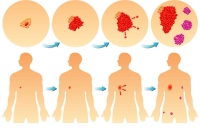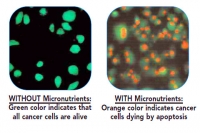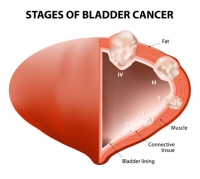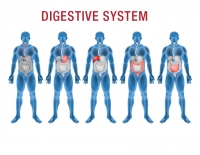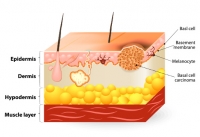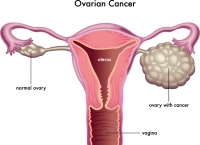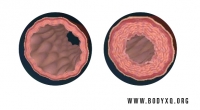11 / 13 / 2015
Sarcoma is a cancerous growth developing in the cells of the connective tissue. Primary cancers that develop in the soft connective tissues such as in the muscles, nerves, blood vessels, and fat cells, are called soft tissue sarcomas, versus osseous sarcomas, which develop in hard connective tissue such as in the bones and cartilage. Connective tissue is abundantly present everywhere in the body, and therefore soft tissue sarcomas can occur anywhere. However, the most common locations for soft tissue sarcomas are in the arms and legs, followed by the organs in the abdominal cavity. While it is a rare type of cancer and constitutes about 1% of all adult cancers, the American Cancer Society estimates that in 2015, approximately 12,000 adults will be newly diagnosed with soft tissue sarcoma, and 4,870 adults may die due to this disease.
10 / 30 / 2015
Apoptosis, also referred to as “programmed cell death,” or “cell suicide,” originates from a combination of Greek words that can be loosely translated as “falling off.” Apoptosis is a physiological process essential for the development and function of the human body and other multicellular organisms. Millions of cells routinely die in the bone marrow and intestines every hour. It is estimated that approximately 50-70 billion cells die due to apoptosis every day in an average human adult.
10 / 15 / 2015
Cancer of the urinary bladder is the fourth most common cause of cancer in men. Most bladder cancer patients tend to be older men over the age of 60. The American Cancer Society estimates that in 2015, approximately 74,000 new cases of bladder cancer will be diagnosed in the US.
10 / 01 / 2015
Kidneys are a part of the urinary system. A pair of fist-sized kidneys is located in the flanks on either side of the vertebral column. The main function of the kidneys is to form urine by removing water and waste products from the body. Urine is then stored in the urinary bladder to be later excreted.
09 / 17 / 2015
The human digestive system is approximately 16 feet long and it is estimated that the digestive system will process more than 25 tons of food over the course of our lifetime! The function of our digestive system is to convert the foods that we eat into bioenergy for the cells to use for maintenance, growth, and repair. Although we tend to think of the digestive system in terms of organs such as the stomach, intestines, liver and pancreas, these digestive organs are made up of different types of specialized cells.
09 / 10 / 2015
Skin cancer is the most common of all types of cancers. While melanoma is the most feared skin cancer, non-melanoma skin cancers are far more common. The American Cancer Society estimates 73,000 Americans will be diagnosed with melanoma in 2015; however, there will be 3.5 million new cases of non-melanoma cancers.
08 / 21 / 2015
The skin is not only the largest organ in the body, it is also a mirror of the health of the body’s internal organs. In addition to protection of inner tissue structures, the skin helps in regulation of body temperature and elimination of metabolic waste products. Many diseases of the digestive, cardiovascular, and nervous systems, and hormonal imbalances and inflammatory conditions are reflected on the skin. With approximately 20 square feet of surface area, the skin is primarily taken care of for cosmetic appeal. Thousands of skin care products cater to beauty and health conscious consumers who hope to avoid acne, discoloration and signs of aging, as well as skin cancer. It is estimated that the global skin care products industry revenue will be $102.3 billion by 2018.
08 / 07 / 2015
Cervical cancer is the third most commonly diagnosed cancer and the fourth most common cause of death in women. The American Cancer Society estimates 12,900 new cases of cervical cancer will be diagnosed in 2015. Most women diagnosed with cervical cancer are between 30 to 60 years old. While the routine Pap test has reduced cervical cancer deaths in developed countries, it remains a major cause of deaths in women in developing countries. According to 2012 data, approximately 528,000 new cases of cervical cancer were diagnosed worldwide.
07 / 27 / 2015
Psoriasis is an autoimmune, chronic inflammatory skin disease characterized by thickened, red skin with silvery scaled patches. These patches typically occur on the scalp, elbows, knees, and lower back. Although the exact cause of psoriasis is not clear, it is not a contagious disease. Psoriasis affects 2-3% of the world’s population, and men and women between the ages of 15 and 45 are equally affected.
07 / 10 / 2015
The ovaries are part of the female reproductive system and are located on each side of the uterus. They are responsible for the storage and release of an egg every month during a woman’s childbearing years, and the production of the hormones estrogen and progesterone. Estrogen and progesterone control the menstrual cycle and pregnancy, and have protective effects on the heart, bones and multiple organ systems in women.
06 / 25 / 2015
The uterus, commonly referred to as the “womb,” is a hollow and highly expandable organ responsible for accommodating the growing fetus during the nine months of pregnancy. The uterus is made up of strong, involuntary muscles that contract during menstruation and childbirth. Abnormal contractions of the uterine muscles may cause severe cramps during menstruation. During pregnancy, the abnormal and untimely uterine contractions could lead to premature labor and delivery. A normal healthy pregnancy usually lasts up to 40 weeks. If the infant is born before the 37th week of pregnancy, it is termed a “preterm birth.” According to the Centers of Disease Control and Prevention (CDC), 11.4% of the pregnancies in the US ended in preterm delivery in 2013. Preterm delivery is also the cause of approximately 35% of all infant deaths.
06 / 12 / 2015
The nutritional requirements of men and women differ. A woman’s body needs extra nutritional support during various physiological transitions such as puberty, menstruation, pregnancy, lactation, and menopause. Women are affected by different health problems than men and are more often diagnosed with autoimmune diseases, arthritis, osteoporosis, and depression. Despite popular belief that heart disease is a male problem, one in four menopausal women die from heart disease making heart disease, not cancer, the major cause of death of American women. At different stages of life, women benefit from properly selected micronutrients to assure the optimum function of the cells building the nervous, immune, cardiovascular, and endocrine systems.
06 / 02 / 2015
Over 3 million Americans over 40 suffer from some sort of visual impairment. Vision loss is one of the major causes of disabilities, and age related eye diseases (AREDs) are rapidly becoming a public health problem in developed countries. Visual impairment caused by AREDs can lead to other serious health issues, including decreased mobility, depression, hip fractures, other accidents, and an overall lower quality of life. Most AREDs do not have effective treatments and it is important to maintain eye health and to prevent vision deterioration.
05 / 15 / 2015
Scurvy (known as “Sailor’s disease”) is a condition resulting from a complete depletion of ascorbic acid (vitamin C). It is a fatal disease characterized by a slow dissolution of connective tissue throughout the body including the walls of the blood vessels. This disease was quite common in earlier centuries, especially among sailors whose diet was deprived of vitamin C. During long voyages at sea many died within months from tremendous blood loss. Today fully developed scurvy is rare; however, subclinical scurvy is very common especially in the elderly, infants, children on special diets, and people with poor dietary habits.
05 / 11 / 2015
Heart attacks and strokes have consistently remained the leading causes of deaths. Atherosclerosis, the underlying cause of these diseases, results in 17 million deaths each year. Yet, high blood cholesterol levels, a fatty diet, and obesity have been blamed as the causes of heart disease. However, cutting down dietary fat and the artificial reduction of blood cholesterol with cholesterol-reducing medicines have not been successful in addressing this issue. Atherosclerotic plaques occur primarily in the coronary arteries rather than in the entire 60000-mile-long vascular system. The absence of plaque in the veins and the fact that animals do not suffer from atherosclerosis while humans do cannot be explained by conventional medicine and the cholesterol theory of heart disease.
04 / 16 / 2015
Heart Failure is a serious health condition where the heart is unable to pump enough oxygenated blood to other parts of the body. According to the Centers for Disease Control and Prevention (CDC), about 5.1 million people in the US are affected by heart failure and about 40-50% of them die within one year of diagnosis. The economic impact of heart failure is huge, as the national heart failure treatment costs average about $32 billion including the work absences. Worldwide, approximately 23 million people suffer from heart failure.
